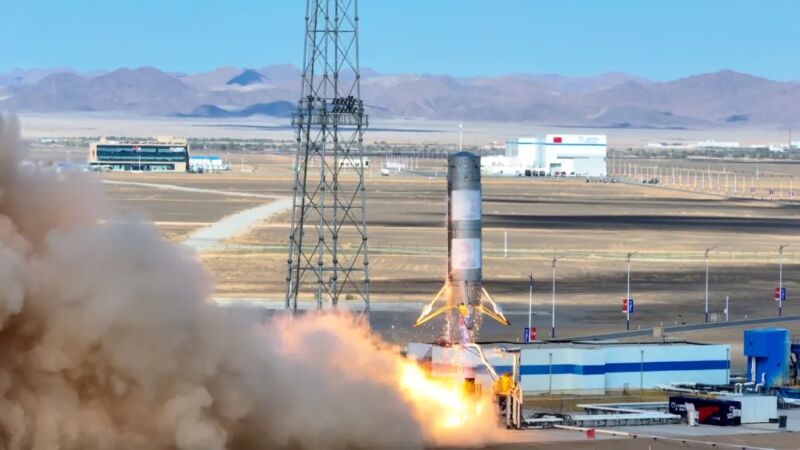Ascendant —
Launch startups in China and Europe are borrowing ideas and rhetoric from SpaceX.

Enlarge / Landspace's reusable rocket test vehicle lifts off from the Jiuquan Satellite Launch Center on Wednesday, September 11, 2024.
Welcome to Edition 7.11 of the Rocket Report! Outside of companies owned by American billionaires, the most imminent advancements in reusable rockets are coming from China's quasi-commercial launch industry. This industry is no longer nascent. After initially relying on solid-fueled rocket motors apparently derived from Chinese military missiles, China's privately funded launch firms are testing larger launchers, with varying degrees of success, and now performing hop tests reminiscent of SpaceX's Grasshopper and F9R Dev1 programs more than a decade ago.
As always, we welcome reader submissions. If you don't want to miss an issue, please subscribe using the box below (the form will not appear on AMP-enabled versions of the site). Each report will include information on small-, medium-, and heavy-lift rockets as well as a quick look ahead at the next three launches on the calendar.

Landspace hops closer to a reusable rocket. Chinese private space startup Landspace has completed a 10-kilometer (33,000-foot) vertical takeoff and vertical landing test on its Zhuque-3 (ZQ-3) reusable rocket testbed, including a mid-flight engine reignition at near supersonic conditions, Aviation Week & Space Technology reports. The 18.3-meter (60-foot) vehicle took off from the Jiuquan launch base in northwestern China, ascended to 10,002 meters, and then made a vertical descent and achieved an on-target propulsive landing 3.2 kilometers (2 miles) from the launch pad. Notably, the rocket's methane-fueled variable-thrust engine intentionally shutdown in flight, then reignited for descent, as engines would operate on future full-scale booster flybacks. The test booster used grid fins and cold gas thrusters to control itself when its main engine was dormant, according to Landspace.
"All indicators met the expected design" ... Landspace hailed the test as a major milestone in the company's road to flying its next rocket, the Zhuque-3, as soon as next year. With nine methane-fueled main engines, the Zhuque-3 will initially be able to deliver 21 metric tons (46,300 pounds) of payload into low-Earth orbit with its booster flying in expendable mode. In 2026, Landspace aims to begin recovering Zhuque-3 first-stage boosters for reuse. Landspace is one of several Chinese companies working seriously on reusable rocket designs. Another Chinese firm, Deep Blue Aerospace, says it plans a 100-kilometer (62-mile) suborbital test of a reusable booster soon, ahead of the first flight of its medium-class Nebula-1 rocket next year. (submitted by Ken the Bin)
The easiest way to keep up with Eric Berger's space reporting is to sign up for his newsletter, we'll collect his stories in your inbox.
Isar Aerospace sets low bar for success on first launch. Daniel Metzler, CEO of German launch startup Isar Aerospace, stated that the first flight of the Spectrum rocket would be a success if it didn’t destroy the launch site, European Spaceflight reports. During an interview at the Handelsblatt innovation conference, Metzler was asked what he would consider a successful inaugural flight of Spectrum. “For me, the first flight will be a success if we don’t blow up the launch site,” explained Metzler. “That would probably be the thing that would set us back the most in terms of technology and time.” This tempering of expectations sounds remarkably similar to statements made by Elon Musk about SpaceX's first flight of the Starship rocket last year.
In the catbird seat? ... Isar Aerospace could be in a position to become the first in a new crop of European commercial launch companies to attempt its first orbital flight. Another German company, Rocket Factory Augsburg, recently gave up on a possible launch this year after the booster for its first launch caught fire and collapsed during a test at a launch site in Scotland. Isar plans to launch its two-stage Spectrum rocket, designed to carry up to 1,000 kilograms (2,200 pounds) of payload into low-Earth orbit, from Andøya Spaceport in Norway. Isar hasn't publicized any schedule for the first flight of Spectrum, but there are indications the publicity-shy company is testing hardware at the Norwegian spaceport. (submitted by Ken the Bin)
FAA to introduce new orbital debris rules. The Federal Aviation Administration is moving ahead with efforts to develop rules for the disposal of upper stages as another Centaur upper stage breaks apart in orbit, Space News reports. The FAA released draft regulations on the matter for public comment one year ago, and the head of the agency's commercial spaceflight division recently said the rules are a "high priority for our organization." The rules would direct launch operators to dispose of upper stages in one of five ways, from controlled reentries to placement in graveyard or “disposal” orbits not commonly used by operational satellites. One change the FAA might make to the draft rules is to reduce the required timeline for an uncontrolled reentry of a disposed upper stage from no more than 25 years to a shorter timeline. “We got a lot of comments that said it should be a lot less,” said Kelvin Coleman, head of the FAA's commercial spaceflight office. “We’re taking that into consideration.”
Upper stages are a problem ... Several recent breakups involving spent upper stages in orbit have highlighted the concern that dead rocket bodies could create unnecessary space junk. Last month, the upper stage from a Chinese Long March 6A disintegrated in low-Earth orbit, creating at least 300 pieces of space debris. More recently, a Centaur upper stage from a United Launch Alliance Atlas V rocket broke apart in a much higher orbit, resulting in more than 40 pieces of debris. This was the fourth time one of ULA's Centaur upper stages has broken up since 2018. (submitted by Ken the Bin)